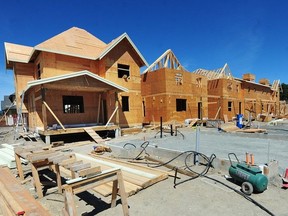Opinion: The housing bubble is bursting – globally. Recent buyers and overstretched investors are in jeopardy because of climbing rates, especially in Canada

Twelve months ago, during the pandemic housing boom, the suburbs of Langley and Mission were deluged with buyers. Anxious bidding wars ensued.
Spurred on by the dream of working remotely, the desire for more living space, unusually high government stimulus and chronically elevated values in core Metro Vancouver, buyers — including investors — were manically driving up prices in the Fraser Valley by more than 20 per cent compared to a year earlier.
But the housing bubble is bursting — globally — in a way it hasn’t for decades. The end of a long boom, often taken for granted, appears to be ending.
Recent buyers and overstretched borrowers are in jeopardy, especially in Canada and especially the suburbs.
“The most vulnerable economies look to be Canada, Taiwan, Finland, and New Zealand,” says Adam Slater, Oxford’s senior analyst. Royal Bank of Canada economists predict sales in this country will plummet by 40 per cent next year.

Central banks around the world are raising interest rates more rapidly than in almost four decades. Markets that spiked have a sudden cutback of buyers and investors who were seduced by mortgage rates of three per cent. Many can’t afford fixed rates of six to seven.
The average house price in Chilliwack is now down 30 per cent, to $705,000, from its peak in February. Similarly, average values in Langley, of $1 million, reflect a plunge of about 40 per cent from the peak — even while prices in both cities remain somewhat higher than before the pandemic.
Suburban Toronto prices have also been pummelled. Yet it can’t be forgotten that even with the declines of the past half year, Greater Toronto and Metro Vancouver stubbornly retain some of the most unaffordable housing in the world. The benchmark price of all homes, including condos, in Greater Vancouver is still $1.15 million.
Yet the global slump is very real. What’s causing it?
One answer is: What goes up the fastest goes down the fastest. Since 2020 overall prices are up by more than 30 per cent in Canada, the Netherlands and the U.S. Now prices are falling in nine of 18 economically advanced countries surveyed by Oxford Economics. This year the drop has already been 14 per cent across Canada.

Another reason for the anxious exposure of Canadian homeowners is that debt levels here are among the highest in the world. Average household debt in Canada, at 186 per cent of disposable income, is much heavier than in Germany or the U.S.
Canadians are also likely to get more quickly battered by climbing mortgage rates. Fixed-term borrowing is the norm in most countries, especially the U.S. But in Canada half of all mortgages are variable; they float up and down with central bank rates.
What are some impacts on Canada’s real-estate market?
The proportion of condos being bought as pre-construction presales, which are often flipped when completed, has plummeted. New housing construction has also decreased, along with projections that sales and prices will steadily decline as a recession looms.
Politicians around the world feel pressure to come up with would-be rescue operations to preserve home ownership, which many voters count on for security.
The International Monetary Fund is urging policy makers to consider protections against rising mortgages. Spain, Hungary and New Zealand are taking up the challenge.

While many question the Liberal strategy in regard to unemployment, wages and housing affordability, they say it is the main thing that could keep overly vulnerable Canadian prices from crashing. Steve Saretsky’s real-estate report notes Ottawa’s policies led to Canada’s population increasing by a record 700,000 year over year (compared to 250,000 in 2015).
“Population growth certainly helps provide a floor under housing,” said the Vancouver analyst. “It doesn’t mean this correction is over, far from it. However, from a fundamental perspective it would be naive to ignore the rate at which this country is growing, particularly in our major urban centres.”

While the former housing minister once championed the foreign-buyers, vacancy and speculation taxes to curb demand, Eby’s current goals include promising a tax on real estate flipping (which can hike prices) and more public funding for housing.
In a global housing world now most strongly characterized by ascending mortgage rates and plunging values, what will be the fate of Canadians who have not had a chance to move into home ownership?
Some believe there will be an upside to the crisis and that lower prices will allow more Canadian young people to buy homes.
In Canada the battle for affordability for a reasonable housing market is far from over.
@douglastodd

Post a Comment